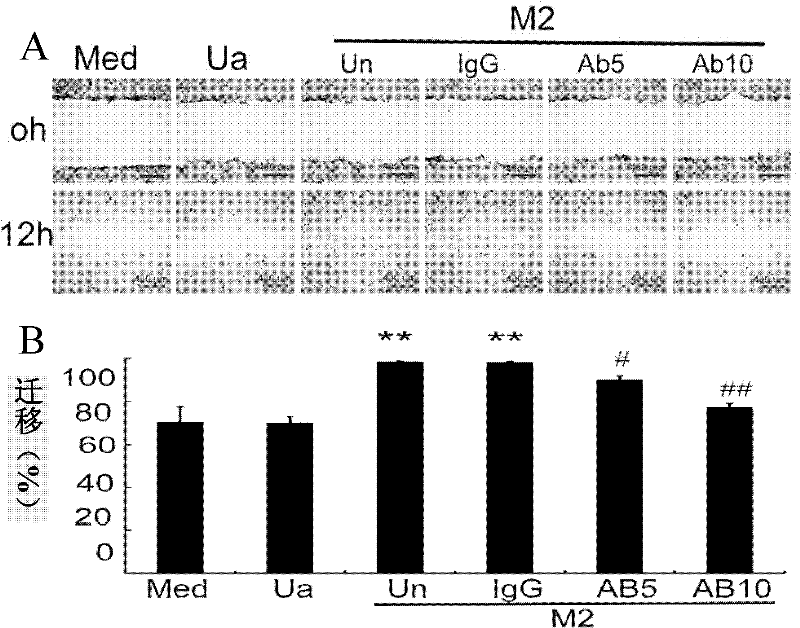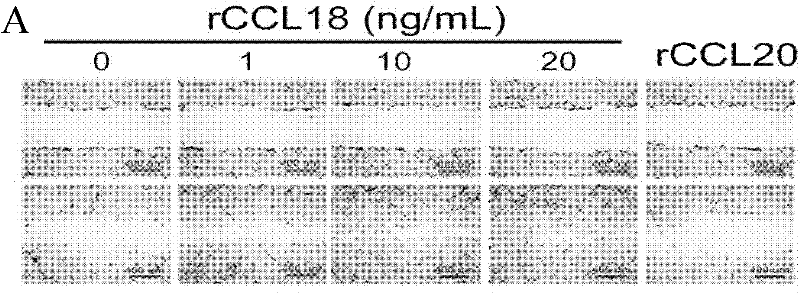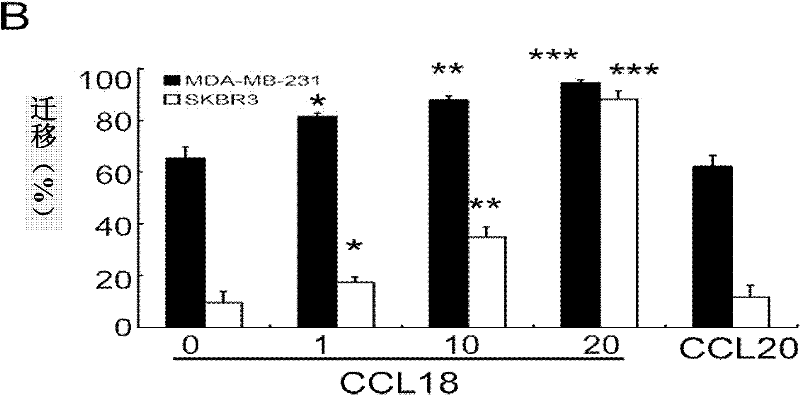Application of PITPNM3 gene in preparing medicine for inhibiting breast cancer invasion and transfer
A breast cancer, drug technology, applied in application, gene therapy, drug combination and other directions, can solve problems such as hindering the development of breast cancer migration methods
- Summary
- Abstract
- Description
- Claims
- Application Information
AI Technical Summary
Problems solved by technology
Method used
Image
Examples
Embodiment 1
[0052] Example 1: The experiment of CCL18 promoting the invasion and migration of breast cancer
[0053] To investigate the function of CCL18, we designed a scratch assay to evaluate the effect of secreting and expressing CCL18 macrophages on the invasion and migration of breast cancer. Specifically, the experimental method is as follows: culture breast cancer cells at a density of 90%, use a pipette tip to draw a straight line on the cell monolayer, put the nest of selectively activated macrophages that secrete CCL18 into the culture system, add DMEMF12 Under the culture conditions of 0.4% BSA, B2720ul / ml, and EGF insulin, they were co-cultured for 12 hrs. The pictures of 0h and 12h were taken under a phase-contrast microscope, and the distances on both sides of the scratches at 0h and 12h on the pictures were analyzed by Carnoy software (Biovolution), and the percentage of the cell migration distance and the non-migration distance was calculated. It was proved that breast c...
Embodiment 2
[0054] Example 2: Experiment to prove that PITPNM3 is a transmembrane receptor activated by CCL18
[0055] In order to identify whether there is CCL18 receptor on the breast cancer cell membrane, MDA-MB-231 cells were incubated with CCL18 at 4°C for 3 h, fixed, and stained with Alexa488-labeled CCL18 antibody. Immunofluorescence staining demonstrated that CCL18 was present on the membrane of breast cancer cells ( image 3 A), suggesting that there are special protein molecules on the surface of breast cancer cells that can bind to CCL18 and mediate the biological effects of CCL18. In addition, adding a neutralizing antibody to CCL18 during the incubation of CCL18 with cells can prevent CCL18 from binding to breast cancer cell surface proteins ( image 3 B).
[0056] In order to identify unknown functional receptors of CCL18, we first treated breast cancer MDA-MB-231 cells with CCL18 protein, then extracted cell membrane proteins, and co-immunoprecipitated the membrane protei...
Embodiment 3
[0060] Example 3 PITPNM3 mediates CCL18 to promote breast cancer invasion and migration
[0061] In order to further explore the CCL18-PITPNM3 interaction in breast cancer cells, we demonstrated that silencing the expression of PITPNM3 with siRNA would affect the effect of CCL18 on breast cancer cells. The siRNA sequences are: PITPNM3 siRNA-1: sense strand 5′-GGGAGAAGUGGCUUCGUAATT-3′ antisense strand: 5′-UUACGAAGCCACUUCUCCCGG-3′; PITPNM3 siRNA-2: sense strand 5′-CGCGCAUGAUCCUGCGCAATT-3′ antisense strand: 5′- UUGCGCAGGAUCAUGCGCGAG-3'. Silencing the expression of PITPNM3 in breast cancer cells can significantly inhibit the role of CCL18 in promoting the migration of breast cancer cells to the level of breast cancer cell migration without the effect of CCL18 (P Figure 8 ). Transfection of breast cancer cells without rCCL18 effect with PITPNM3-siRNA did not affect the cell invasion and migration function (P>0.05, Figure 8 ). These results indicate that the biological function ...
PUM
 Login to View More
Login to View More Abstract
Description
Claims
Application Information
 Login to View More
Login to View More - R&D
- Intellectual Property
- Life Sciences
- Materials
- Tech Scout
- Unparalleled Data Quality
- Higher Quality Content
- 60% Fewer Hallucinations
Browse by: Latest US Patents, China's latest patents, Technical Efficacy Thesaurus, Application Domain, Technology Topic, Popular Technical Reports.
© 2025 PatSnap. All rights reserved.Legal|Privacy policy|Modern Slavery Act Transparency Statement|Sitemap|About US| Contact US: help@patsnap.com



